Abstract
A novel Energy Selective Filter (ESF) mounted in waveguide is presented based on nonlinear element, which is sensitive to the power intensity of incident wave achieving frequency selection as well as energy selection. The proposed ESF consists of three parts, the middle circuit board with diode loaded, the upper and bottom ground metallic patches. The mechanism of the ESF is analyzed through equivalent circuit model and its performance is investigated numerically and experimentally. According to the waveguide measurement, a shielding effectiveness of 13 dB is achieved in case of high power input and the insertions loss is less than 0.3 dB across the whole frequency range when low power signal inputs. It is a pluggable component in waveguide that could reflect high power signals of specific frequency to protect the following electronic equipment.
1. Introduction
High power microwaves can cause interference or damage to sensitive receivers, sensors and other electronic equipments. To protect the circuits, waveguide limiters and filters are widely used because of their low insertion loss, large power capacity and easy batch production.
In recent years, metasurfaces loaded with lumped elements have aroused the interest of researchers. Typical lumped elements utilized in metasurfaces include PIN diodes [1] and resistors [2]. Particularly, some articles have applied the metasurfaces to design waveguide limiter and filter. In [3] an electromagnetic band gap (EBG) waveguide low-pass filter loaded with double-array was introduced to improve the stopband characteristics, which achieved broader gap-band width, larger stopband attenuation, and smaller passband insert loss than the traditional filters. To achieve reconfiguration, some waveguide filters loaded nonlinear components. For example, ref [4] presented a reconfigurable band-stop waveguide filter by incorporating varactor diodes in the microstrip ring element. In addition, Ref. [5] presented a miniaturize power limiter which used coupled self-complementary electric inductive-capacitive (CELC) structure loaded with a Schottky diode to achieve the effect of a nonlinear power limiter. However, the above filter does not have energy selection characteristics, and the limiter does not have frequency selection characteristics. Thus, to realize limiter and filter function simultaneously with simple structure is a novel idea.
Frequency selective surface (FSS), as the representative of metasurfaces, is a periodic surface with identical two-dimensional arrays of elements arranged on a dielectric substrate, which is used to transmit in-band signals and reflect out-band electromagnetism incidence [6]. Based on the resistor-loaded frequency selective surface (FSS), absorbers can be tuned to achieve a broadband absorption between 1 and 12 GHz [2]. With the pin diodes mounted, an active metamaterial with electrical control of both polarization and frequency was introduced in [7]. Transistors applied in nonlinear microwave absorbers in [8] made the absorption rate to be controlled either directly by the system, or indirectly by feedback that in response to the power level. On the basis of FSS, Yang Cheng et al. first reported the energy selective surface (ESS), which looks like a limiter, with pin-diode for EMP protection which only sensitive to the power density or field intensity of incident wave [9]. Subsequently, a spatial power limiter using a nonlinear FSS was researched combining the frequency selection characteristics of FSS and the energy selection characteristics of ESS [10,11]. However, as planar structures, the aforementioned structures should be fabricated at the front end of antenna to defend HPM and HPEM threats, just like a radome, which takes a lot of space and will inevitably affect the antenna pattern.
In this article, a novel Energy Selective Filter (ESF) with power-dependent transmission coefficient in waveguide is illustrated. Compared with previous work, this design adopts only one unit cell and is a pluggable component in waveguide. It can limit the amplitude of a specific frequency band, that is characteristic of frequency selection and energy selection, thus providing protection for the equipment. The signal can pass almost without loss when the power is small. While, it would reflect the energy of the designed frequency when the power exceeds a certain threshold, just likes a band-stop filter. The proposed ESF has greater flexibility in design and can provide an effective way for high-power microwave protection.
Structural Design and Analysis
The structure of the design is illustrated in Figure 1, which is comprised of three parts, i.e., the intermediate circuit, the upper and bottom ground patches, which are all made by printed circuit boards (PCB), and the substrate is FR-4 with permittivity of 4.5 and thickness of 0.8 mm. The upper and bottom patches are exactly the same in length and width with a dimension of . Besides, these two thin ground planes are separated by air and connected by the another PCB with a metal line (the size is ) and a diode loaded.
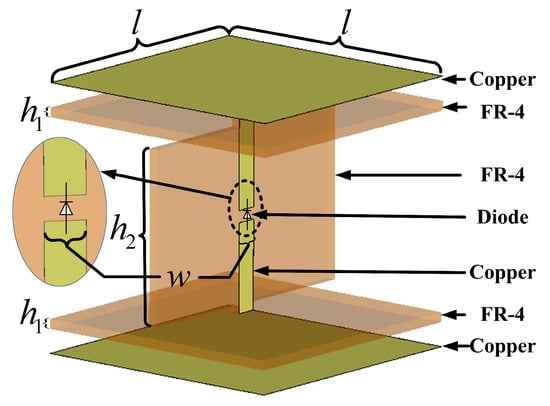
Figure 1.
Geometry of the proposed ESF.
The mechanism of this power-dependent ESF is mainly based on the principle of series resonance of capacitor and inductor in waveguide, equivalent circuit of which is shown in Figure 2. The upper plane is capacitively coupled with the top of the waveguide and the coupling capacitance is . Similarly, the coupling capacitance of the bottom plane is . Obviously, if the structure is symmetrical, should be equal to . Although there is coupling capacitance between the two planes, it is much weaker since the area smaller than that of the waveguide wall and can be ignored compared with and . The intermediate metallic wire is connected by the diode to achieve nonlinear performance, which acts as an inductor L when the diode is triggered by high power. The waveguide can be modeled by a shunt LC circuit or depending on the frequency [12,13]. Because the proposed ESF works in the main mode TE, frequency of which is above the cut-off frequency, the equivalent circuit can be simplified to Figure 2c,d.

Figure 2.
ESF in waveguide and equivalent circuit.
If the voltage induced by incident wave is not enough to turn on the diode, the resistance for an ideal diode in negative biasing status (off-state) is infinite and no resonance can be excited. Since the resonance condition cannot be satisfied, the whole structure only acts as two metal sheets placed independently in the waveguide. Since the resonant circuit is not conducting and the boundary conditions of the waveguide remain unchanged, the mode of incident wave dose not changed, and the power is rarely reflected. Thus, the small signal can pass through the waveguide with less loss.
In contrast, at the condition of high power, such AC voltage can bias the diode mounted in the gap positively or negatively. For PIN diodes, carriers are injected into intrinsic layer during the half-cycle of positive bias and migrated out of intrinsic layer during the half-cycle of negative bias. Because the carrier injection rate is higher than the outgoing rate, a certain charge will be accumulated in the intrinsic layer, and the diode will work stably in the on-state. For an ideal PIN diode, the resistance is zero in on-state, which means that the middle metal line is shorted. In this situation, the whole structure is equivalent to a series resonant circuit of capacitor and inductor as shown in Figure 2c, and the impedance of the proposed ESF is given by
Thus, the input impedance from port 1 is
is waveguide impedance. The input impedance becomes zero at the resonance frequency , which is
The incident signal at frequency is reflected completely, whose reflection coefficient is calculated by
The capacitance C is determined by the area () and the distance of the patches and waveguide wall. According to the characteristics of general parallel plate capacitors, equivalent capacitance C is proportional to patch area S and inversely proportional to distance . Besides, the inductance L is related to the width w and length of the metal wire. The distributed inductance L would increases as the width w and the length decrease. Therefore, by adjusting these three parameters, the equivalent inductance and capacitance can be adjusted to change the resonant frequency.
The above analysis is based on the assumption that diodes are ideal switches. However, the parasitic effects are inevitable. In this design, a PIN diode with low parasitical-capacitances, short switching time and small on-resistance is needed. After comparison, silicon PIN diode of BAP-51-02 from NXP Corporation is selected. By measuring the transmission coefficients of the diode in the case of on and off conditions respectively to obtain the parameters of the diode. The diodes 51-02 have an approximate capacitance of 0.15 pF at off-state, while it is equivalent to a series of resistor 0.7 and inductor 0.77 nH at on-state.
When the incident power of the waveguide is 1 watt, the voltage at both ends of the diode varies with frequency obtained by simulation as shown in Figure 3. The different structure size makes the maximum voltage and frequency different, but the frequency corresponding to the maximum voltage is the same as the frequency in Figure 4. The results show that dimension not only determines the frequency characteristics, but also affects the threshold power level of the ESF. With the increase of resonance frequency, the threshold level decreases.
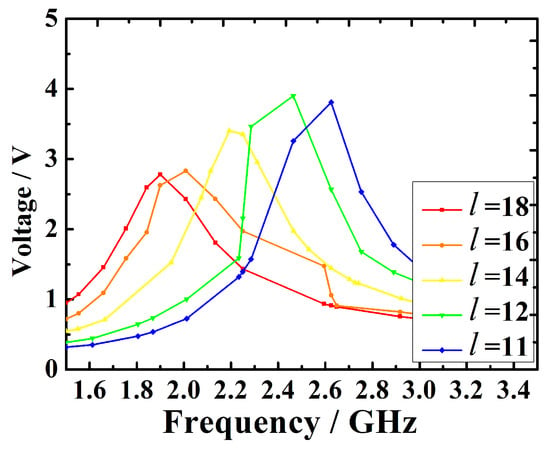
Figure 3.
Induced voltage at both ends of the diode with 1 watt incidence power.

Figure 4.
with different widths of metal patches when the diode is in on-state by (a) full wave and (b) equivalent circuit simulation.
In standard waveguide WR430 with dimension 109.22 mm × 54.61 mm, the transmission coefficients of proposed ESF with different patch sizes are obtained by full-wave simulation. As shown in Figure 4a, the resonance frequency is in inverse proportion to the length l of the ground patches. Subsequently, the capacitance C and inductance L values corresponding to different sizes are calculated by numerical fitting for circuit simulation in Table 1 and the equivalent circuit is simulated by Advanced Design System (ADS) software. Only the width l of patches is changed, thus the equivalent inductance nH remains basically constant. When diode is in on-state, it can be seen that the resonant frequency is in negative correlation with the width l, which has a direct influence on the equivalent capacitance C. The simulation results of equivalent circuit are consistent with full-wave simulation as shown in Figure 4b. Nevertheless, when diode is in off-state, the loss is very small and can be neglected as shown in Figure 5.

Table 1.
Simulation parameters ( mm, mm, mm, nH).
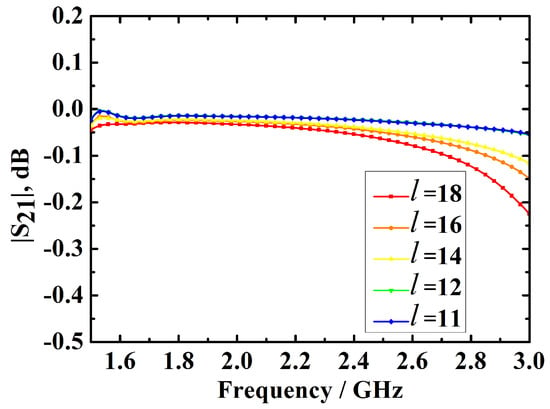
Figure 5.
with different widths of metal patches by full wave simulation when the diode is off.
Figure 6 shows the field distributions of TE10 at two different frequencies in the waveguide when diode is on and off, respectively. The structural parameters are mm, mm, mm and mm, of which the resonant frequency in on-state is 1.98 GHz. When the diode is off, signals of all frequency can pass almost without loss as shown in Figure 6a,c, which is consistent with the for analysis corresponding to small signal. When the input power is high, the diode is turned on automatically, and the signal of resonant frequency is cut-off as shown in Figure 6b. While, other signals can be passed and the mode of electromagnetic wave dose not be changed much, which is shown in Figure 6d. Therefore, it can be verified that ESF has dual characteristics of energy selection and frequency selection in waveguide, without external driving voltage, and is completely self-actuated. It can be applied to the waveguide to realize high power protection in certain frequency.

Figure 6.
Electric field distributions at condition of diode (a) off and (b) on at 2.0 GHz, diode (c) off and (d) on at 2.6 GHz.
2. Results and Discussion
For verifying the performance of the ESF proposed in this article, a prototype is made with parameters mm, mm, mm and mm and resonant frequency 1.98 GHz as shown in Figure 7. Experimental setup of waveguide measurement with high power incident wave is shown in Figure 8. The signal at port 1 of the Vector Network Analyzer (VNA) is amplified by the Power Amplifier, then input into the waveguide in which the prototype ESF is installed, and finally flow-back in to port 2 of the VNA through an Attenuator. By changing the output power of port 1, the conditions of high power and small signal in waveguide can be obtained respectively.

Figure 7.
Views of fabricated ESF in waveguide.
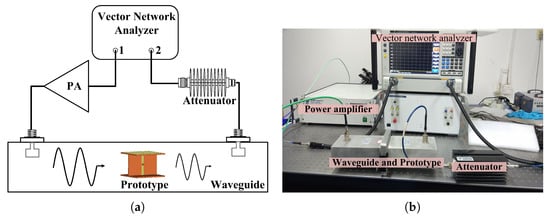
Figure 8.
(a) Measurement diagram and (b) the picture of measurement.
When a high power signal is injected, the transmission coefficient measured is shown in Figure 9a. The ESF with loaded diode works as a band-stop filter at around 2 GHz with input power of 33 dBm. Furthermore, the transmission coefficient of the ESF is obtained with metal wire instead of the diode, which is equivalent to the case when the ideal diode is turned on. The result of metal wire are consistent with that of the simulation, which is also presented in Figure 9a. Comparing with metallic wire in the gap of intermediate circuit, the shielding of the ESF loaded diode is not ideal. That is because the on-resistance of the diode is not small enough. However, with a maximum shielding effect of 13 db, it can reflect 95% of the energy and still provide effective protection for the back-end circuit. Contrarily, when the input power is 0 dBm, small signal cannot stimulate the diode to turn on. The measured insertion loss of ESF is less than 0.3 dB as shown in Figure 9b, which is consistent with the simulation results.
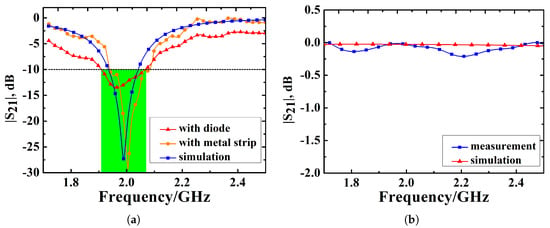
Figure 9.
Results with input power (a) 33 dBm and (b) 0 dBm.
3. Conclusions
A novel Energy Selective Filter with power-dependent transmission effectiveness in waveguide is presented in this letter. It not only has the frequency selection performance, but also the energy selection characteristic. From the simulation results, the frequency selection characteristics can be adjusted by changing the size of the structure. The designed prototype achieves more than 13 dB shielding effect near 2 GHz for high power signal and has insertion loss less than 0.3 dB for low power signal. This novel ESF can provide an effective way for high-power microwave protection at designed frequency range. In addition, the component is pluggable, which can be re-used in high power microwave protection applications.
Author Contributions
Funding acquisition, J.L.; Investigation, Z.W. and M.L.; Methodology, Z.W. and J.Z.; Writing original draft, Z.W.
Funding
This research received no external funding.
Conflicts of Interest
The authors declare no conflict of interest.
Abbreviations
The following abbreviations are used in this manuscript:
| ESF | Multidisciplinary Digital Publishing Institute |
References
- Li, H.; Cao, Q.; Wang, Y. A Novel 2-B Multifunctional Active Frequency Selective Surface for LTE-2.1 GHz. IEEE Trans. Antennas Propag. 2017, 65, 3084–3092. [Google Scholar] [CrossRef]
- Li, J.; Jiang, J.; He, Y.; Xu, W.; Chen, M.; Miao, L.; Bie, S. Design of a Tunable Low-Frequency and Broadband Radar Absorber Based on Active Frequency Selective Surface. IEEE Antennas Wirel. Propag. Lett. 2016, 15, 774–777. [Google Scholar] [CrossRef]
- Tang, Y.; Yu, Y.; Wu, W. Improved EBG-loaded waveguide low-pass filter. Microw. Opt. Technol. Lett. 2008, 50, 2090–2093. [Google Scholar] [CrossRef]
- Mias, C.; Tsakonas, C. Electrically and mechanically tunable waveguide filter. Microw. Opt. Technol. Lett. 2004, 42, 13–15. [Google Scholar] [CrossRef]
- Loo, Y.L.; Wang, H.G.; Zhang, H.; Ong, C.K. Miniaturized power limiter metasurface based on Fano-type resonance and Babinet principle. Opt. Express 2016, 24, 20816–20824. [Google Scholar] [CrossRef] [PubMed]
- Anwar, R.S.; Mao, L.; Ning, H. Frequency Selective Surfaces: A Review. Appl. Sci. 2018, 8, 1689. [Google Scholar] [CrossRef]
- Zeng, X.; Zhang, L.; Wan, G.; Gao, M. Active metamaterial absorber with controllable polarisation and frequency. Electron. Lett. 2017, 53, 1085–1086. [Google Scholar] [CrossRef]
- Li, A.; Kim, S.; Luo, Y.; Li, Y.; Long, J.; Sievenpiper, D.F. High-Power Transistor-Based Tunable and Switchable Metasurface Absorber. IEEE Trans. Microw. Theory Tech. 2017, 65, 2810–2818. [Google Scholar] [CrossRef]
- Yang, C.; Liu, P.G.; Huang, X.J. A Novel Method of Energy Selective Surface for Adaptive HPM/EMP Protection. IEEE Antennas Wirel. Propag. Lett. 2013, 12, 112–115. [Google Scholar] [CrossRef]
- Deng, F.; Xi, X.; Li, J.; Ding, F. A Method of Designing a Field-Controlled Active Frequency Selective Surface. IEEE Antennas Wirel. Propag. Lett. 2015, 14, 630–633. [Google Scholar] [CrossRef]
- Chen, Z.; Chen, X.; Xu, G. A spatial power limiter using a nonlinear frequency selective surface. Int. J. RF Microw. Comput.-Aided Eng. 2018, 28. [Google Scholar] [CrossRef]
- Nosrati, M.; Daneshmand, M. Substrate Integrated Waveguide L-Shaped Iris for Realization of Transmission Zero and Evanescent-Mode Pole. IEEE Trans. Microw. Theory Tech. 2017, 65, 2310–2320. [Google Scholar] [CrossRef]
- Nosrati, M.; Abbasi, Z.; Daneshmand, M. Single-Layer Substrate-Integrated Waveguide Evanescent-Mode Filter. IEEE Microw. Wirel. Compon. Lett. 2018, 28, 1107–1109. [Google Scholar] [CrossRef]
© 2019 by the authors. Licensee MDPI, Basel, Switzerland. This article is an open access article distributed under the terms and conditions of the Creative Commons Attribution (CC BY) license (http://creativecommons.org/licenses/by/4.0/).